
Say the word Phantom, and most Broadway buffs will immediately think of the Sir Andrew Lloyd Webber megahit, currently in its 21st year on Broadway (over 8500 performances to date). But there’s another Phantom which will pop into the minds of true musical theater aficionados, the single-word-titled Phantom (no Of The Opera here), with book by Arthur Kopit and music and lyrics by Maury Yeston. Though the closest the “other Phantom” has gotten to Broadway is New Jersey, over the past 17 years it has become a regional theater staple (over 1000 regional performances), and now graces the Glendale Centre Theatre stage, in a production whose performances alone make it well worth seeing.
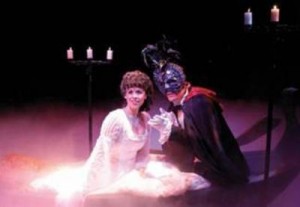 Like Sir Andrew’s Phantom, the Kopit/Yeston version takes place in the Paris Opera House, where (to quote one of its songs), “the opera’s been invaded by a phantom.” As in the better known Phantom, the masked man falls in love with an enchanting young soprano named Christine, and in both versions, as in the countless films which have been based on the original novel by Gaston Leroux, the phantom’s hideously deformed face proves too much for Christine to gaze upon, leading to a tragic tear-jerking finale.
Like Sir Andrew’s Phantom, the Kopit/Yeston version takes place in the Paris Opera House, where (to quote one of its songs), “the opera’s been invaded by a phantom.” As in the better known Phantom, the masked man falls in love with an enchanting young soprano named Christine, and in both versions, as in the countless films which have been based on the original novel by Gaston Leroux, the phantom’s hideously deformed face proves too much for Christine to gaze upon, leading to a tragic tear-jerking finale.
Yet so much is different about the two musical Phantoms that whether you’re a confirmed P.O.T.O. fan or (in my own case) less than enthralled by the “international sensation,” Kopit/Yeston’s Phantom deserves a look-see.
 Here, the Phantom has a name (Erik) and is much more human a person than Lloyd Webber’s. Gone is the romantic triangle of Raoul, Christine, and the Phantom. (Here, the lovely Miss Daaé is discovered by Count Philippe de Chandon.) In its place is a deeper exploration of Erik’s past, and of his relationship with Gérard Carrière, the head of the Opera House, who has protected Erik over the years by allowing him to live his lonely life in the theater’s catacombs, for reasons that do not become clear until the musical’s eleventh hour. Also, Kopit’s book is a lot more fun than Sir Andrew’s, especially in scenes featuring the diva to end all divas, opera superstar (in her own mind) Carlotta, possessed of one of the most comically grating sopranos in opera history.
Here, the Phantom has a name (Erik) and is much more human a person than Lloyd Webber’s. Gone is the romantic triangle of Raoul, Christine, and the Phantom. (Here, the lovely Miss Daaé is discovered by Count Philippe de Chandon.) In its place is a deeper exploration of Erik’s past, and of his relationship with Gérard Carrière, the head of the Opera House, who has protected Erik over the years by allowing him to live his lonely life in the theater’s catacombs, for reasons that do not become clear until the musical’s eleventh hour. Also, Kopit’s book is a lot more fun than Sir Andrew’s, especially in scenes featuring the diva to end all divas, opera superstar (in her own mind) Carlotta, possessed of one of the most comically grating sopranos in opera history.
Phantom is Glendale Centre Theatre’s 642nd production. (In its 63rd year, GCT is the longest continuously-running “centre staged” theatre in the country.) Phantom is also, as one of their frequent patrons commented last night, quite possibly their best sung ever. Since “centre staged” (their spelling) is a fancy way of saying “theater in the round” (my spelling), GCT productions are performed without traditional sets, though furniture and props are brought on stage to set the various scenes. Having other audience members as backdrop to the action can be a bit of a distraction and require more suspension of disbelief than in a traditional proscenium production. On the other hand, no other 400+ seat theater in the Southland can put this many patrons so close to what’s happening on stage. A show like Phantom, whose spectacle often overpowers the personal scenes, can actually gain power in this more intimate setting.
With Angela Wood of The Costume Shoppe providing costuming for Phantom, the production is elegant indeed, its opening sequence filling the stage with gorgeously bedecked 19th Century Parisians including various townspeople, a puppeteer, a Pierrot, a balloon seller, a flower girl, etc. Inside the Opera House, ballerinas straight out of a Degas painting are dancing, surrounded by masked opening night celebrants in their elegant finest.
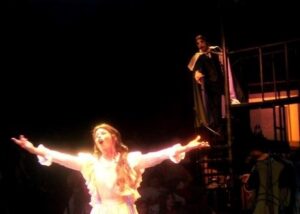 Before long, Carrière is fired from his position as head of the Opera House, his replacement poo-pooing the notion that a ghost haunts the theater. The “ghost” is of course the very much alive Erik, who for the first time in his life has resorted to killing another human being, an unfortunate soul who had the bad luck to see his face. “All my life I have lived by threatening to kill,” he tells Carrière, “and now I have.”
Before long, Carrière is fired from his position as head of the Opera House, his replacement poo-pooing the notion that a ghost haunts the theater. The “ghost” is of course the very much alive Erik, who for the first time in his life has resorted to killing another human being, an unfortunate soul who had the bad luck to see his face. “All my life I have lived by threatening to kill,” he tells Carrière, “and now I have.”
Meanwhile, Carlotta, wife of the new theater owner, is practicing her “vocalizing” in a soprano that at times comes perilously close to a cackle. “Her voice is worse than my face,” Erik tells Carrière. (With lines like this one, this Phantom is indeed a lot more fun than the other.) Christine arrives with an introduction from Philippe to Carrière, only to learn to her dismay that Carrière has gotten the sack and that Philippe has a “reputation” as a love-em-and-leave-em Count. Christine does get hired, however, to work in the costume department, and it is while she is doing some extemporaneous singing that Erik first hears her voice, and falls in love.
Then again, who wouldn’t fall in love with the exquisite soprano of Heather Lundstedt as Christine? The Azusa Pacific college student is possessed of a voice that can hold its own against any of Broadway’s Christines, and a beauty that would win the heart of any Phantom. Remember the name. Heather Lundstedt. You’ll be hearing it again and again.
The same can be said for Phantom Kelby Thwaits, Equity Guest Artist and “John Brown” in the recent Queen Victoria musical A Piece Of Tin. Thwaits may well be one of the youngest and handsomest (even under the mask) Phantoms ever, but it makes total sense that Erik should still be a young man who would have, had fate treated him differently, won women’s hearts by the score, especially with a gorgeous tenor like Thwaits’. As an actor, Thwaits shines equally, revealing the tortured, loving soul under the mask. (Actually, this Phantom changes masks more often than Queen Elizabeth changes hats.)
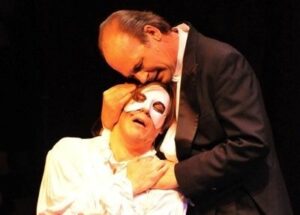 In supporting roles, George Champion is a marvelous Carrière, bringing warmth, dignity, and a superb voice to the role, especially in the heartbreaking “You Are My Own.” Rita Tarin is a hoot as Carlotta, milking the role for all it’s worth. (Listen to the way she holds the “screw” in “scrutinize” an extra beat or two or three.) Bryan Vickery is a dashing and fine-voiced Phillippe, duetting the jaunty “Who Could Ever Have Dreamed You Up?” opposite Lundstedt. Todd Andrew Ball is funny indeed as Alain Cholet, Carlotta’s husband and the new Opera House owner, but what’s with the French accent when virtually nobody else has one? Whitney Ackerman and Genevieve Mariko Wilson show their balletic grace in a flashback sequence. In fact, the entire ensemble* have just the right “look” for Phantom, and voices to match.
In supporting roles, George Champion is a marvelous Carrière, bringing warmth, dignity, and a superb voice to the role, especially in the heartbreaking “You Are My Own.” Rita Tarin is a hoot as Carlotta, milking the role for all it’s worth. (Listen to the way she holds the “screw” in “scrutinize” an extra beat or two or three.) Bryan Vickery is a dashing and fine-voiced Phillippe, duetting the jaunty “Who Could Ever Have Dreamed You Up?” opposite Lundstedt. Todd Andrew Ball is funny indeed as Alain Cholet, Carlotta’s husband and the new Opera House owner, but what’s with the French accent when virtually nobody else has one? Whitney Ackerman and Genevieve Mariko Wilson show their balletic grace in a flashback sequence. In fact, the entire ensemble* have just the right “look” for Phantom, and voices to match.
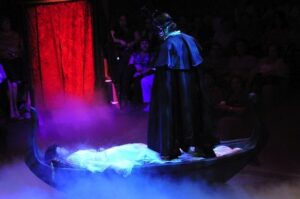 Director George Strattan deserves highest marks for taking a big proscenium show and restaging it in the round. The “centre staged” setting works particularly well in a flirtatious cat-and-mouse sequence with Christine circling the rolling clothes rack behind which Erik is hiding, trying to get a glimpse of his face as he proposes to become her voice teacher.
Director George Strattan deserves highest marks for taking a big proscenium show and restaging it in the round. The “centre staged” setting works particularly well in a flirtatious cat-and-mouse sequence with Christine circling the rolling clothes rack behind which Erik is hiding, trying to get a glimpse of his face as he proposes to become her voice teacher.
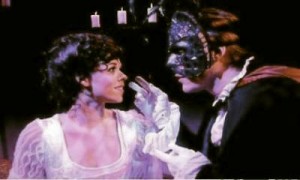 Janet Renslow has choreographed Phantom, with the ballet sequences dance standouts. Musical director Steven Applegate has the entire cast singing in perfect harmony to prerecorded tracks. Tim Dietlein deserves high marks for creating the show’s various locales without the benefit of a traditional set, and for his excellent lighting design. Sound technician Casey Serrano does his best with GCT’s somewhat tinny sound system, which does not always do justice to the voices on stage.
Janet Renslow has choreographed Phantom, with the ballet sequences dance standouts. Musical director Steven Applegate has the entire cast singing in perfect harmony to prerecorded tracks. Tim Dietlein deserves high marks for creating the show’s various locales without the benefit of a traditional set, and for his excellent lighting design. Sound technician Casey Serrano does his best with GCT’s somewhat tinny sound system, which does not always do justice to the voices on stage.
However, in this production the performances are the thing, and they are all- around splendid. Add to that the humor and the heart of Kopit’s book and the beautiful melodies that are a Yeston hallmark, and you have a production that will touch your heart and send you out of the theater with a song on your lips.
Glendale Centre Theatre, 324 N. Orange St., Glendale.
www.glendalecentretheatre.com
–Steven Stanley
September 24, 2008
*Vartan Antonyan, Tanner Arden (Young Erik), Sarah Carson, Elijah Cornelius, Paul Coutinho, Christopher Gomez (Buquet), Valerie K. Jasso (Opera Diva), Richard Malmos (Inspector Ledoux), Ken Martinez, Christina Noland (Flora), Tony Pinizzotto (Jean-Claude), Bridget Pugliese, Angela Raile (Fleure), Laurel Robinson (Florence), Emma Strattan (Little French Girl), Jennifer Strattan (Second Girl From The Right), James Warnock (Opera Tenor/Oberon), Don Woodruff (Minister Of Culture)


 Since 2007, Steven Stanley's StageSceneLA.com has spotlighted the best in Southern California theater via reviews, interviews, and its annual StageSceneLA Scenies.
Since 2007, Steven Stanley's StageSceneLA.com has spotlighted the best in Southern California theater via reviews, interviews, and its annual StageSceneLA Scenies.







 COPYRIGHT 2024 STEVEN STANLEY :: DESIGN BY
COPYRIGHT 2024 STEVEN STANLEY :: DESIGN BY